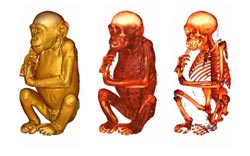Long bone shape: a family affair

Great ape virtopsy: virtual preparation of skin, muscles, and bone of a young chimpanzee. UZH<br>
PhD student Naoki Morimoto, member of the Computer-Assisted Paleoanthropology group of Ch. Zollikofer and M. Ponce de León, and junior author of the study, was surprised by his own findings. Although humans are bipeds, and chimps are quadrupeds, muscle attachment sites at their thighbones are quite similar.
Attachment sites differ substantially, however, between chimpanzees and gorillas, although these great apes species move similarly. Interestingly, Morimoto’s results are in line with insights from genetics: humans and chimps are evolutionary sister species, while gorillas are more distant relatives, like cousins. Morimoto explains the seeming paradox of his results: this is not «form follows function», but «form follows family».
Functional inferences: a cautionary tale
The new findings have far-reaching implications for the interpretation of fossil hominin remains. Fossil thighbone shafts are often well preserved, but it now appears that inferences about locomotor behavior must be drawn with caution, while inferences about the fossil’s evolutionary relationships might be more straightforward. Anthropologist Ch. Zollikofer explains: «the transition from great-ape-like quadrupedal to human-like bipedal locomotion is accompanied by several changes in the hip and thighbones, but currently we cannot infer functional change from structural change with any certainty.» And he asks the next big question of paleoanthropology: «Why did the last common ancestor of humans and chimps, who might have lived 7-8 million years ago, evolve novel thighbone features?»
Virtual dissection
To get a detailed look at great ape musculoskeletal anatomy, the research team combined high-resolution computed tomography with computer-assisted virtual dissection. Great ape bodies are a scarce and valuable resource for scientific studies, and anthropologists are increasingly reluctant to «sacrifice» them for anatomical dissections. Virtual autopsy – or Virtopsy – is the method of choice. Virtopsy was pioneered by Michael Thali (Institute of Forensic Science, UZH), and is now used in forensic institutes worldwide. Anthropological virtopsy has enormous potential, as it permits virtual dissection of one single specimen by many different researchers, and according to many different criteria, without actually deteriorating the orginal body. Moreover, great ape virtopsy gives an immediate picture of the spatial relationships between soft and hard tissues (bones) of one and the same individual. Traditionally, bone morphology was studied on dry-skeleton specimens, and subsequently combined with muscle data obtained from dissections of other animals.
Acquiring 3D tomographic data of great ape bodies, however, is a complex endeavor, which requires collaboration across disciplines. To reach these goals, the «Visible Ape Consortium» was established, which has become an example of efficient transdisciplinary research at UZH (see below).
Literature:
Naoki Morimoto, Marcia S. Ponce De Leόn, Takeshi Nishimura and Christoph P.E. Zollikofer: Femoral Morphology and Femoropelvic Musculoskeletal Anatomy of Humans and Great Apes: A Comparative Virtopsy Study, in: The Anatomical Record, 294:1433–1445 (2011), DOI 10.1002/ar.21424
The Visible Ape Consortium:
Dr. Marcia Ponce de León and Prof. Christoph Zollikofer of the Anthropological Institute of the University of Zurich initiated the Visible Ape Consortium to acquire, archive and analyze 3D tomographic data of great ape bodies for anatomical and morphological research. Currently the following institutions form part of the Consortium: the Anthropological Institute, the Department of Diagnostic Imaging of the Vetsuisse Faculty (Prof. P. Kircher), the Institute of Forensic Science (Prof. M. Thali), the Center for Integrative Human Physiology (Prof. M. Gassmann), and Zoo Zurich. Close collaboration has been established with the Kyoto University Primate Research Institute in Inuyama, Japan (Dr. T. Nishimura).
Contact
Naoki Morimoto
Anthropological Institute
University of Zurich
Tel. +41 44 635 54 41
E-Mail: morimoto@aim.uzh.ch
Media Contact
More Information:
http://www.uzh.chAll latest news from the category: Life Sciences and Chemistry
Articles and reports from the Life Sciences and chemistry area deal with applied and basic research into modern biology, chemistry and human medicine.
Valuable information can be found on a range of life sciences fields including bacteriology, biochemistry, bionics, bioinformatics, biophysics, biotechnology, genetics, geobotany, human biology, marine biology, microbiology, molecular biology, cellular biology, zoology, bioinorganic chemistry, microchemistry and environmental chemistry.
Newest articles

Machine learning algorithm reveals long-theorized glass phase in crystal
Scientists have found evidence of an elusive, glassy phase of matter that emerges when a crystal’s perfect internal pattern is disrupted. X-ray technology and machine learning converge to shed light…

Mapping plant functional diversity from space
HKU ecologists revolutionize ecosystem monitoring with novel field-satellite integration. An international team of researchers, led by Professor Jin WU from the School of Biological Sciences at The University of Hong…

Inverters with constant full load capability
…enable an increase in the performance of electric drives. Overheating components significantly limit the performance of drivetrains in electric vehicles. Inverters in particular are subject to a high thermal load,…





















